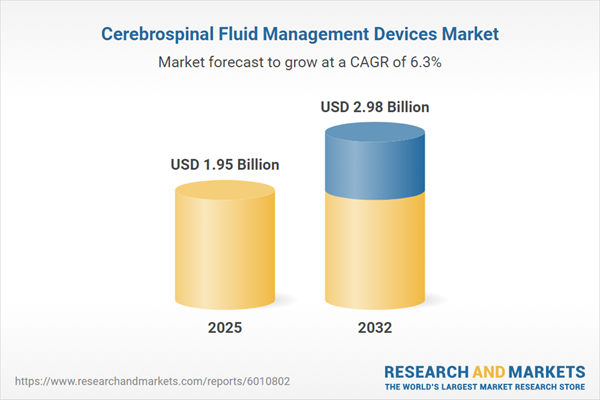Speak directly to the analyst to clarify any post sales queries you may have.
Senior executives in neurological care must align strategies with changing technologies and care models to maintain competitiveness. The cerebrospinal fluid management devices market is navigating new demands for efficiency, clinical compliance, and evolving regulatory frameworks—requiring leaders to pursue informed, agile decisions for sustainable growth.
Market Snapshot: Cerebrospinal Fluid Management Devices Market
The global cerebrospinal fluid management devices market is projected to grow from USD 1.83 billion to USD 1.95 billion between 2024 and 2025, at a 6.25% compound annual growth rate (CAGR). This growth is supported by an increasing need for precision-engineered shunt systems and integrated monitoring solutions, as healthcare providers emphasize operational reliability and compliance with advancing clinical standards. As digital health technologies shape the sector, manufacturers respond with innovations in device reliability and form strategic partnerships to address emerging regulatory expectations. This evolving environment highlights the critical role of advanced technology and collaboration in achieving improved neurological patient outcomes.
Scope & Segmentation
This report offers targeted and actionable insights tailored for senior stakeholders focused on optimizing investments and strengthening operational performance within the cerebrospinal fluid management devices market. Comprehensive segment analysis uncovers strategic opportunities, supporting focused decision-making across the care continuum.
- Product Types: Accessories, external drainage systems, lumboperitoneal shunts, and ventriculoperitoneal shunts address both intraoperative use and ongoing therapy, with programmable and nonprogrammable designs accommodating diverse neurological needs.
- End Users: Hospitals, ambulatory surgery centers, and home care providers leverage these devices to improve clinical workflow, broaden patient access, and address a range of care needs from urgent interventions to routine monitoring.
- Indications: Devices provide essential support in managing hydrocephalus, resolving cerebrospinal fluid leaks, addressing intracranial hypertension, and controlling intraventricular hemorrhage for comprehensive neurological strategies.
- Distribution Channels: Direct facility purchases, online procurement platforms, and third-party distributors are key supply channels for efficient and responsive delivery of critical devices.
- Technologies: Digital device innovations deliver real-time analytics, customizable drainage settings, and continuous monitoring to reinforce clinical safety and care quality objectives.
- Geographical Regions: The Americas, Europe, Middle East & Africa, and Asia-Pacific present distinct market dynamics shaped by regulatory infrastructure, regional adoption of digital solutions, and care delivery models.
- Key Companies: Medtronic plc, Integra LifeSciences Holdings Corporation, B. Braun Melsungen AG, and Stryker Corporation demonstrate leadership in technical progress and regulatory compliance.
Key Takeaways for Senior Leaders
- Closed-platform device architectures create opportunities for improved clinical oversight and regulatory assurance across healthcare settings.
- Movement toward programmable and minimally invasive device formats streamlines clinical workflow while lowering patient risk, supporting safer and more efficient neurological care.
- Adoption of portable devices allows care teams to efficiently coordinate transitions between acute and post-acute care environments, strengthening continuity.
- Supplier-provider collaboration is enhancing agility, enabling organizations to make informed, data-driven clinical and operational decisions at scale.
- Telemetry and integrated digital connectivity are advancing digital health initiatives, ensuring resilient device performance across distributed care networks.
- Diverse and tailored product options, including a variety of shunts and accessories, help manufacturers and providers quickly adapt to evolving clinical demands.
Tariff Impact and Regulatory Compliance
Recent updates to tariff regulations affecting components imported into the United States are prompting manufacturers to emphasize local sourcing and build regionalized production networks. These measures improve supply chain resilience while reducing dependence on international logistics. Healthcare organizations benefit from reduced supply disruption risks and more predictable operating costs. Such developments underscore the vital importance of agile regulatory compliance strategies and effective inventory management for continuous device availability.
Methodology & Data Sources
This report integrates insights from interviews with clinical, engineering, and procurement professionals, combined with a critical review of peer-reviewed publications, manufacturer documentation, and regulatory filings. Careful validation of shipment and usage data reinforces the accuracy and relevance of the market findings.
Why This Report Matters
- Empowers executive and procurement teams to address technological shifts and complex regulatory environments with clear, actionable frameworks within the cerebrospinal fluid management devices category.
- Delivers concise guidance on specific segment opportunities and operational challenges, supporting informed investment and operational decisions regionally and globally.
- Provides practical benchmarks and actionable evidence to strengthen compliance and advance supply chain resiliency across healthcare facilities.
Conclusion
To remain competitive in cerebrospinal fluid management, organizations must embrace digital innovation and maintain operational adaptability. This analysis equips senior leaders with the strategic context needed to make proactive decisions and sustain organizational progress in an evolving market.
Additional Product Information:
- Purchase of this report includes 1 year online access with quarterly updates.
- This report can be updated on request. Please contact our Customer Experience team using the Ask a Question widget on our website.
Table of Contents
3. Executive Summary
4. Market Overview
7. Cumulative Impact of Artificial Intelligence 2025
Companies Mentioned
The companies profiled in this Cerebrospinal Fluid Management Devices market report include:- Medtronic plc
- Integra LifeSciences Holdings Corporation
- B. Braun Melsungen AG
- Stryker Corporation
- Teleflex Incorporated
- Zimmer Biomet Holdings, Inc.
- Becton, Dickinson and Company
- Nihon Kohden Corporation
- Medtrum Technologies, Inc.
- Sophysa SAS
Table Information
| Report Attribute | Details |
|---|---|
| No. of Pages | 193 |
| Published | October 2025 |
| Forecast Period | 2025 - 2032 |
| Estimated Market Value ( USD | $ 1.95 Billion |
| Forecasted Market Value ( USD | $ 2.98 Billion |
| Compound Annual Growth Rate | 6.2% |
| Regions Covered | Global |
| No. of Companies Mentioned | 11 |









